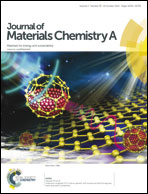Array geometry dictates electrochemical performance of Ge nanowire lithium ion battery anodes†
Abstract
Scientific literature shows a substantial study-to-study variation in the electrochemical lithiation performance of “1-D” nanomaterials such as Si and Ge nanowires or nanotubes. In this study we varied the vapor–liquid–solid (VLS) growth temperature and time, resulting in nanowire arrays with distinct mass loadings, mean diameters and lengths, and thicknesses of the parasitic Ge films that are formed at the base of the array during growth. When all the results were compared, a key empirical trend to emerge was that increasing active material mass loading drastically degraded the electrochemical performance. For instance, GeNWs grown for 2 minutes at 320 °C (0.12 mg cm−2 mass loading, 34 nm mean nanowire diameter, 170 nm parasitic film thickness) had a reversible capacity of 1405 mA h g−1, a cycle 50 coulombic efficiency (CE) of 99.9%, a cycle 100 capacity retention of 98%, and delivered ∼1200 mA h g−1 at 5 C. In contrast, electrodes grown for 10 minutes at 360 °C (0.86 mg cm−2, 115 nm, 1410 nm) retained merely 5.6% of their initial capacity after 100 cycles, had a CE of 96%, and delivered ∼400 mA h g−1 at 5 C. Using TOF-SIMS we are the first to demonstrate marked segregation of Li to the current collector interface in planar Ge films that are 300 and 500 nm thick, but not in the 150 nm specimens. FIB analysis shows that the cycled higher mass loaded electrodes develop more SEI and interfacial cracks near the current collector. A comparison with the state-of-the-art scientific literature for a range of Ge-based nanostructures shows that our low mass loaded GeNWs are highly favorable in terms of the reversible capacity at cycle 1 and cycle 100, steady-state cycling CE and high-rate capability.


 Please wait while we load your content...
Please wait while we load your content...